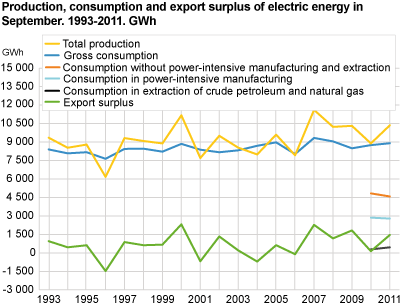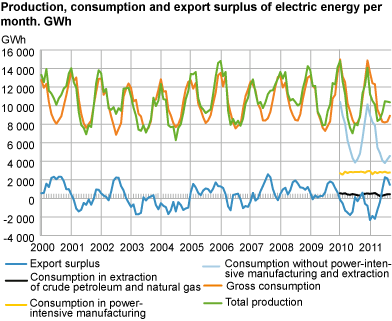Content
Published:
This is an archived release.
High electricity generation
Total electricity generation came to 10 361 GWh in September. This is an increase of 17 per cent compared with the same month last year and the third highest figure ever recorded for the month.
The electricity generation can be viewed in conjunction with the large inflow of water and high filling level in many reservoirs. So far this year, electricity generation amounts to 89.3 TWh; an increase of 3 per cent compared with January-September last year. Hydro power roughly accounts for 95 per cent of the total electricity generation so far this year, whereas thermal and wind power account for 4 and 1 per cent respectively.
More water in the reservoirs
According to the Norwegian Water Resources and Energy Directorate, the reservoir filling was 79.0 per cent at the beginning of September. Throughout the month, the filling increased by 5.8 percentage points to 84.8 per cent at the end of week 38. For the separated elspot areas, the degree of filling varied from 79.5 to 95.4 per cent. The median filling for the corresponding week in the years 1990-2007 is 88.3 per cent.
Exchange of power
The export of electricity came to 1 820 GWh in September, while imports totalled 361 GWh. This gave a net export of 1 459 GWh. So far this year, Norway has roughly imported 10 TWh and exported 9 TWh; giving a net import of 1 TWh.
Decline in electricity consumption excluding power-intensive manufacturing and extraction
Electricity consumption excluding power-intensive manufacturing and extraction amounted to 4 581 GWh in September 2011. This is 5 per cent lower compared with the same month in 2010. The decline may be seen in conjunction with a higher average temperature for Norway as a whole in September this year. So far this year, the electricity consumption excluding power-intensive manufacturing and extraction amounts to 52.1 TWh; a decrease of 7 per cent compared with January-September last year. Households, services and manufacturing other than the power intensive account for the majority of the electricity consumption excluding power-intensive manufacturing and extraction. Much of this electricity consumption is used for heating. The electricity consumption in households amounts to approximately 50 per cent of the electricity consumption excluding power-intensive manufacturing and extraction.
Electricity consumption in power-intensive manufacturing
Electricity consumption in power-intensive manufacturing was 2 788 GWh in September. This is 2.6 per cent lower compared with September 2010. So far this year, the electricity consumption in power-intensive manufacturing amounts to 25.2 TWh; an increase of 0.4 per cent compared with January-September last year.
Tables:
Contact
-
Magne Holstad
E-mail: magne.holstad@ssb.no
tel.: (+47) 40 90 23 42
-
Ingvild Røstøen Ruen
E-mail: ingvild.ruen@ssb.no
tel.: (+47) 40 81 13 97
-
Tom Jonas Billit
E-mail: tom.billit@ssb.no
tel.: (+47) 40 81 13 45
-
Thomas Aanensen
E-mail: thomas.aanensen@ssb.no
tel.: (+47) 40 90 23 48


